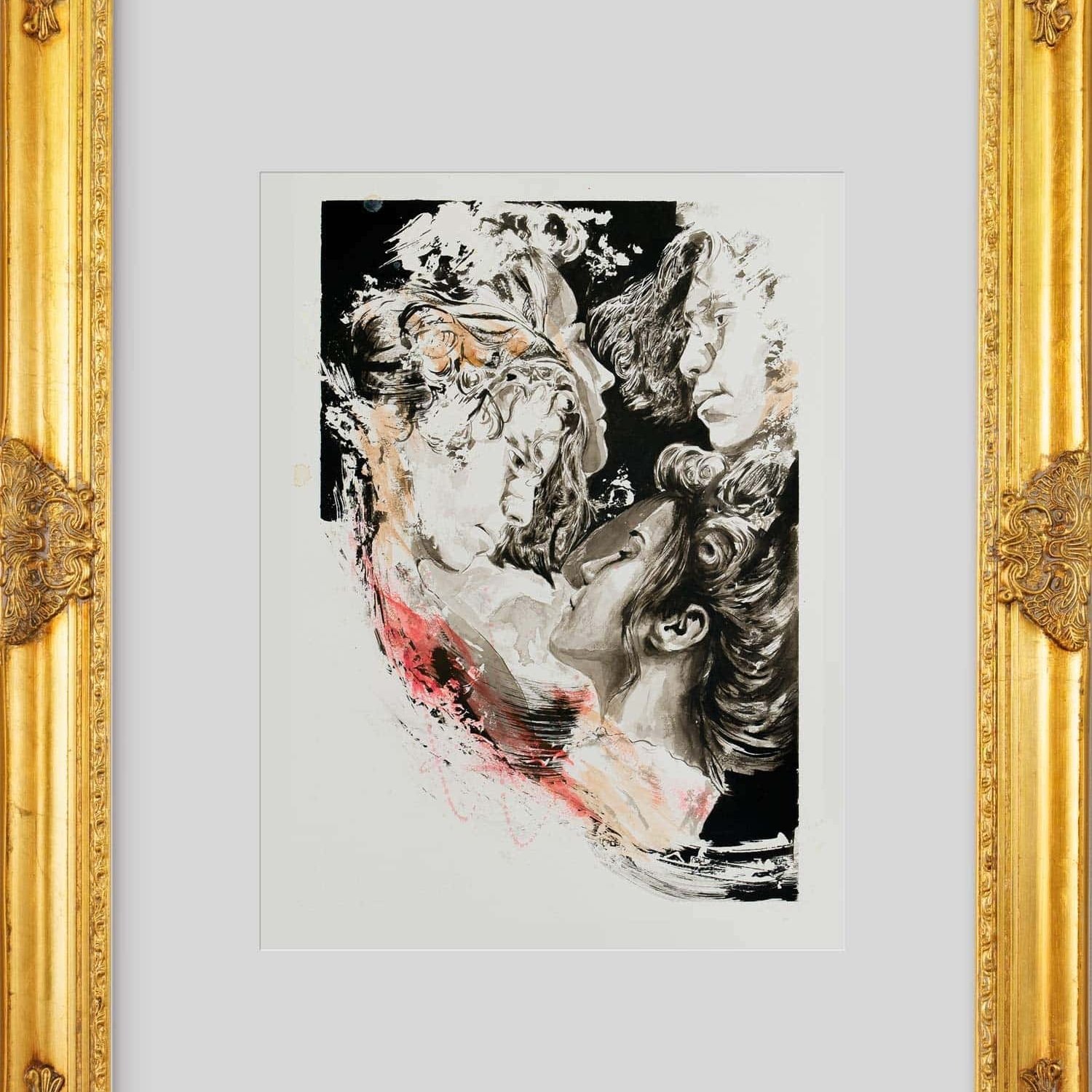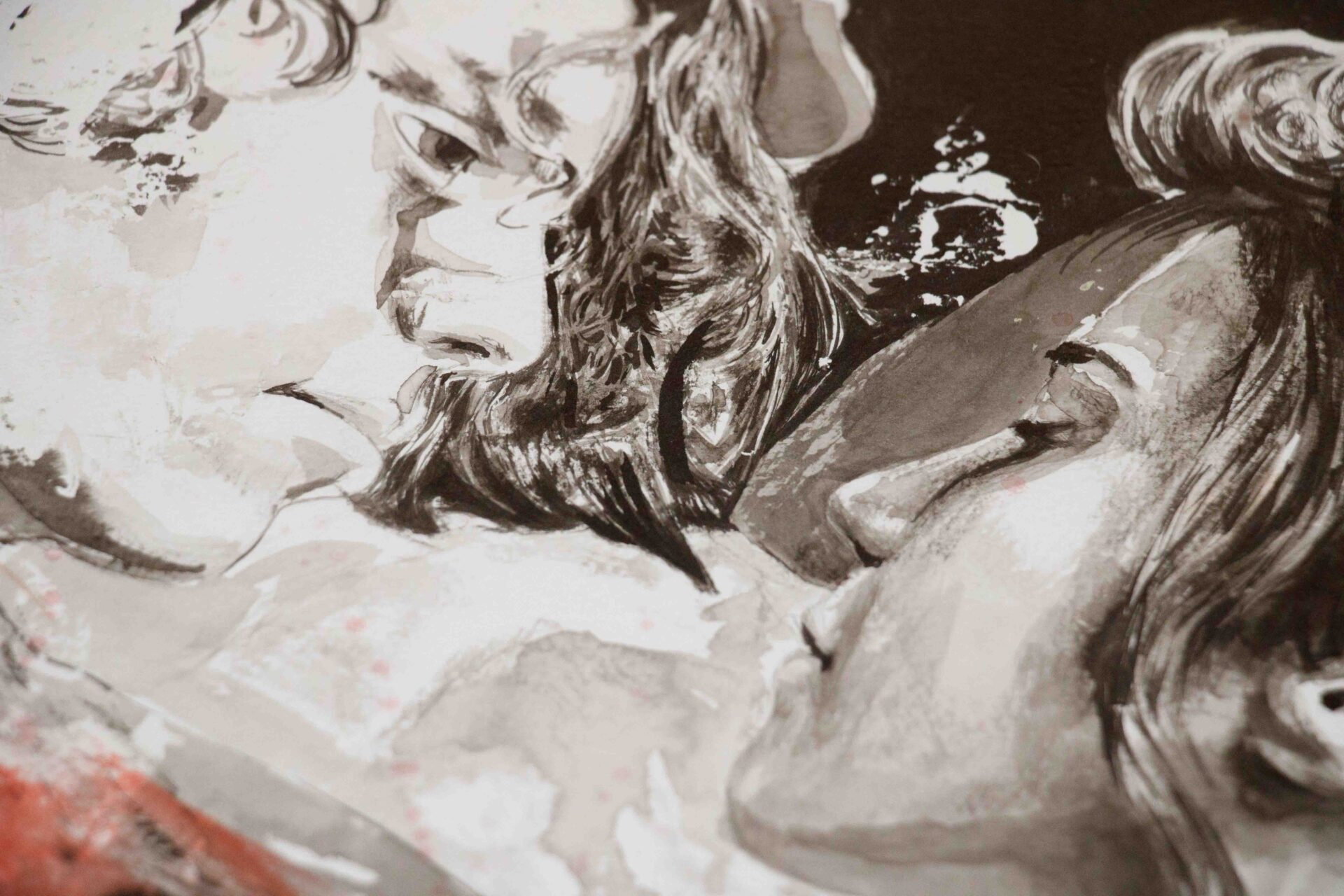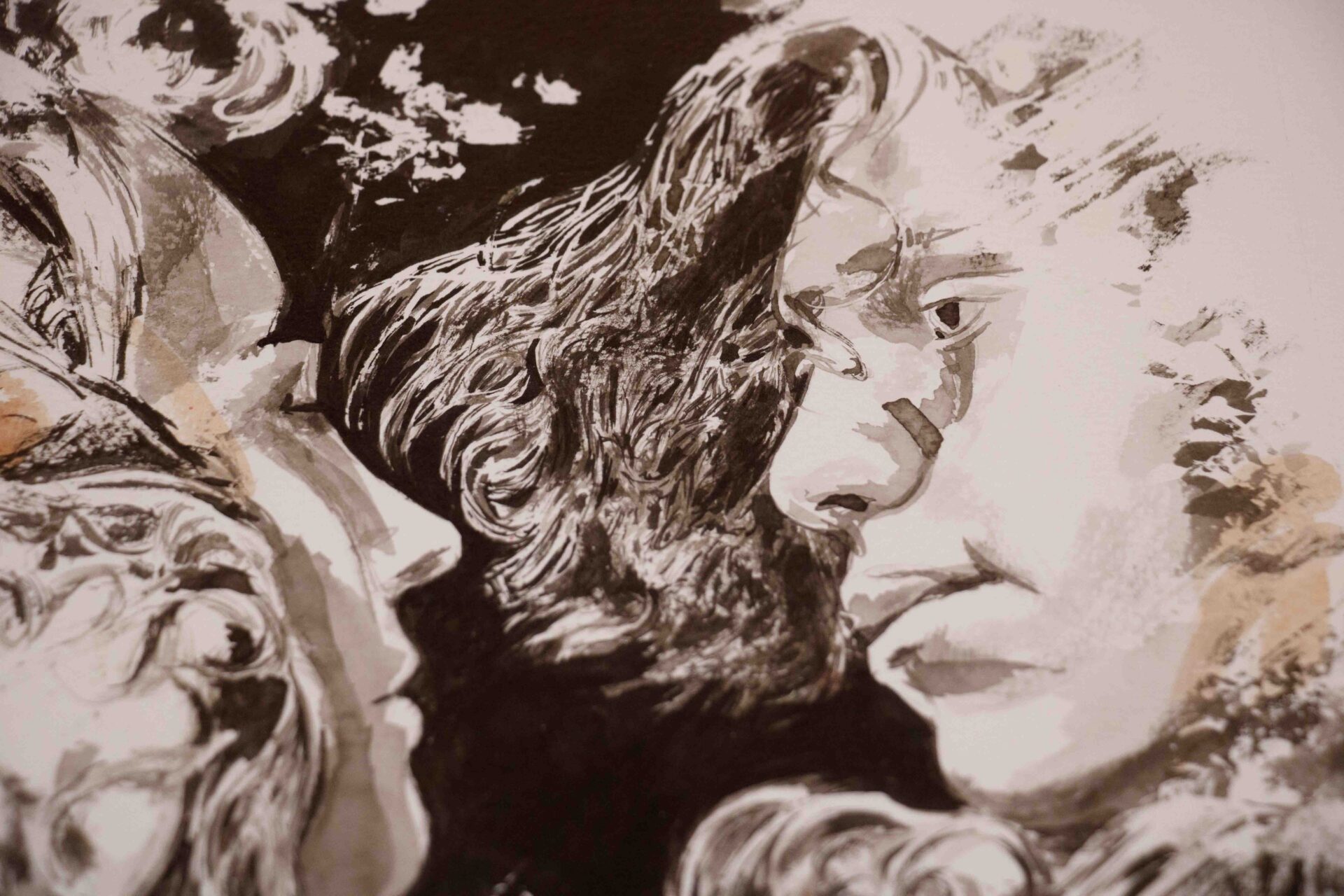Romeo and Juliet’s balcony scene is a famous and iconic moment in Shakespeare’s play. It features Romeo, who has just met Juliet at a party and immediately fallen in love with her, deciding to climb up to her balcony to steal a kiss. This romantic gesture is both daring and poetic and has become a symbol of the intense passion between the two young lovers.
In fact, the balcony scene has inspired many artistic interpretations over the years, such as paintings, sculptures, films, and even fashion collections. For instance, in 2021, a new art collection of mine premiered during Art Basel in Miami entirely inspired by Romeo and Juliet, with the balcony scene as the centerpiece.
This demonstrates the enduring fascination and relevance of this classic tale of love and tragedy.

Art inspired by Romeo and Juliet
My new art collection comprises twelve distinct pieces that are created with a combination of ink, watercolor, and mixed media. Rather than depicting the entire story of Romeo and Juliet, the collection primarily showcases key moments in their relationship.
To add an intriguing twist, the narrative in the exhibition was altered through a “what-if” scenario: “What would have happened if Romeo and Juliet had not died?” This prompted me to explore the different stages and changes that could have occurred in the love story between the two main characters.
The artwork series is designed to highlight these changes and their emotional impact on the two lovers. It is also meant to be an investigation of the journey we all undertake in our own love stories, and the adjustments we need to make within ourselves to sustain a successful relationship.
Through this collection, I wanted to create a story that went beyond the tragic ending of Romeo and Juliet and provided a thought-provoking perspective on the transformative power of love.
Throughout life, we often come across relationships where the initial passion and excitement are abundant, but over time, the spark fades, and the affair fails to grow into something more meaningful. This phenomenon is commonly known as infatuation, which is a temporary state of heightened emotion and physical attraction that often fades once the initial desire has been satisfied.
Unfortunately, many people mistake infatuation for love and enter into relationships based on temporary feelings rather than genuine connections. This can lead to disappointment and heartbreak when the initial passion fizzles out, and the relationship fails to develop into something deeper.
Benvolio finds Romeo hopeless and nearly sick at the beginning of the play because his love has not corresponded with a girl.
“Why, then, O brawling love, O loving hate,
O anything of nothing first created,
O heavy lightness, serious vanity,Misshapen chaos of well-seeming forms,
Feather of lead, bright smoke, cold fire, sick health,Still-waking sleep that is not what it is.
This love feel I, that feel no love in this.”
Romeo and Juliet act 1 scene 1 ( Romeo speaking to Benvolio)
Is it right to celebrate Romeo’s hasty decision to move on and profess his love for Juliet immediately upon meeting her at a party as true love?
Some might argue that Romeo’s quick infatuation with Juliet was a result of youthful passion and an impulsive desire to find love. However, others may contend that true love requires more time and deeper connection to develop, rather than being a sudden and fleeting emotion based solely on physical attraction.
It is crucial to recognize that true love is not just a momentary feeling or a fleeting emotion. It involves a deeper and more profound emotional connection that can only be achieved through time, effort, and a genuine desire to connect with another person.
What makes a relationship last? What makes partners grow?
The question of what it takes to sustain a long-lasting and meaningful relationship is a crucial one. It is one that every couple must ask themselves and answer honestly if they hope to build a strong and lasting connection. Without a clear understanding of what it takes to make a relationship work, it can easily become nothing more than a fleeting and temporary bond.
However, not everyone is willing to make the changes necessary to build a lasting and fulfilling relationship. Many people are searching for their ideal partner but are not willing to make the necessary changes within themselves to become the kind of person that is capable of sustaining a healthy and loving relationship.
Perhaps, if we take inspiration from Romeo’s story, we can find a new perspective on what it takes to build a lasting relationship. Rather than focusing on our own selfish desires and needs, we need to learn to put the needs of our partners first. It is only through selflessness and a willingness to change that we can hope to build the kind of deep and meaningful connection that is the foundation of lasting love.
As an artist, I sought to challenge the traditional visual language associated with Romeo’s story by using watercolors to create a new and unique perspective. By doing so, I aimed to create a new and thought-provoking interpretation of this classic tale that encourages us to reconsider our own assumptions about what it takes to build a meaningful and lasting relationship.
Romeo and Juliet: the balcony scene
At the heart of the collection, there was a particular artwork that stood out – the balcony scene. My intention with this painting was to portray a perfect representation of love, one that goes beyond the physical attraction and youthful foolishness often associated with the two star-crossed lovers.
At first glance, the painting appears to depict a vortex between the two lovers, with each standing face to face in the foreground. However, upon closer inspection, it becomes apparent that there is more to the painting than meets the eye. The image is cleverly constructed to show the lovers’ reflection on the opposite side in the background, creating a deeper and more profound visual representation of their connection.
the two lovers are not only positioned in the foreground but are also reflected on the opposite side of the painting in the background
If you look closely, you will notice that the two lovers are not only positioned in the foreground but are also reflected on the opposite side of the painting in the background. This subtle but intentional detail adds a deeper layer of meaning to the artwork.
For a relationship to endure, it’s important for both partners to be able to empathize with each other and see things from each other’s perspective. In other words, the ability to assume each other’s points of view is a crucial component of a lasting and healthy relationship.
When we view our partner as an extension of ourselves, and they are willing to do the same, it can be a powerful declaration of love. In essence, it’s an expression of the deep level of empathy and understanding we have for each other.
This sentiment is beautifully captured in the words of Romeo and Juliet when they declare to each other, “I am willing to be you.” These simple yet profound words demonstrate the level of selflessness and devotion that is required for a truly enduring and loving relationship.
When both partners are willing to put their egos aside and view each other as extensions of themselves, a deeper and truer form of love can exist that is not solely based on physical attraction or infatuation.
In my artwork inspired by Romeo and Juliet’s love story, I wanted to convey this message of selflessness as the foundation for enduring love. The painting is a visual representation of the idea that when we view our partner as an essential part of ourselves, we create a bond that transcends physical aspects.
In essence, the artwork is meant to inspire the viewer to consider their partner as their own wing or true appendix, recognizing the importance of putting their partner’s needs before their own to create a mutually fulfilling and enduring relationship.
The rendering of the painting
In creating this particular painting, I opted to use Indian ink on watercolor paper. The decision to do so was motivated by my desire to create a graphic novel style image, with the primary colors being black and white.
To add depth and dynamism to the composition, I incorporated splashes of red color. These serve to underscore the sense of movement and energy within the artwork, highlighting the intense passion and emotion that characterizes the love between Romeo and Juliet.
let me know if you like it.

In conclusion, Romeo and Juliet’s story has remained a timeless classic for centuries, captivating audiences with its powerful depiction of love, sacrifice, and tragedy. Through their example, we are reminded of the importance of being willing to change, grow, and adapt to be with someone we love.
As we have seen through the exploration of the artwork collection inspired by Romeo and Juliet, love is a complex and multifaceted emotion that cannot be reduced to mere physical attraction or infatuation. True love requires sacrifice and the willingness to let go of our egos and embrace our partner as an extension of ourselves.
Through the use of different artistic techniques and visual elements, these paintings offer a fresh perspective on the iconic love story, emphasizing the importance of empathy, mutual understanding, and selflessness in building a lasting relationship.
Ultimately, the lessons we learn from Romeo and Juliet’s story are just as relevant today as they were centuries ago, reminding us of the transformative power of love and the incredible heights that we can reach when we are willing to take a chance on it.
About the author
Alex Righetto
Alex Righetto is an Italian artist based in the US, known for his vibrant and bold paintings that reinterpret Italian and European history in a contemporary context. His work has been featured in various exhibitions and publications, including Vanity Fair and Vogue





Do you have anything to day? you can post your comments here, and I will answer anyone.
Alex Righetto, it’s agreat theme you chose. I like your choice of inking to the painting and the use of red color to tell your story.Did you draw that reflected image of Romeo and Juliet from life model or you just composed from imagination.Thank you for your answer…
Thank you for your positive feedback on my artwork. I’m delighted that you liked my theme selection and use of color. To answer your question about the reflected image of Romeo and Juliet, I created it through a photo shoot with models wearing makeup and costumes. I wanted to capture a unique and artistic portrayal of this iconic couple, and I believe the use of photography helped me achieve that. Thank you again for your interest in my work.